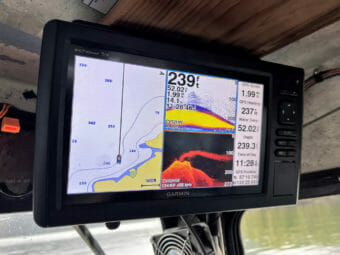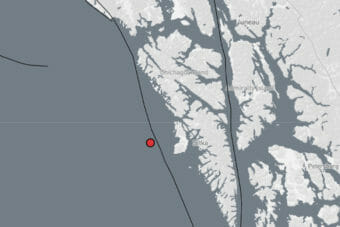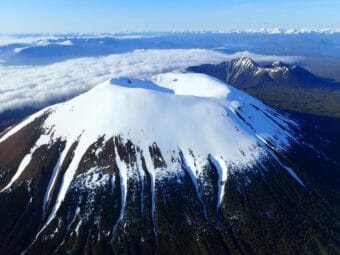
While no eruption is imminent, scientists from the Alaska Geophysical Institute in Fairbanks recently spent a few days on the flanks of Mt. Edgecumbe — and on surrounding beaches — collecting information on surface temperatures and gasses they hope will shed light on what’s brewing beneath the surface.
Carbon dioxide can’t be seen or smelled, but a team of scientists from the Alaska Geophysical Institute knows how to detect it. Six of them spent a few days helicoptering between Sitka and Mt. Edgecumbe in early June, testing the soil of Kruzof Island for CO2.
Claire Puleio is a doctoral student at the University of Alaska Fairbanks. Her team was at the Sitka airport, waiting for a break in the weather.
“We’re hoping to measure diffuse CO2 – those same CO2 measurements we’ve been taking along the flanks of the volcano,” she said. “Then, if we could get inside the crater, we’d like to take some measurements there. However, it’s unclear if it’s snow-free right now.”
Puleio studies under Research Assistant Professor Társilo Girona, who thinks that thermal anomalies on Mt. Edgecumbe detected by satellite data might suggest increased magma activity that could be a precursor to an eruption.
“One of the hypotheses we have to understand those signals,” said Girona, “is that the gas that is moving from the magma source to the surface is producing this warming in the surface.”
The project is funded by NASA as part of a program for early career scientists. The team is tackling the problem on two fronts: in the air and on land.
Carlo Cardellini is from the University Perugia in Italy. He’s helped develop a method for collecting gas from the soil using a device called an accumulation chamber.
“We place a chamber on the top of the soil — it’s like a cooking pot,” said Cardellini. “And we leave the concentration of carbon dioxide to increase inside the chamber. And the rate of increasing is something that is linked to the amount of gas that is passing from the soil to the atmosphere. So we are catching this increase, and we can compute how much gas is escaping from the soil.”

Cardellini uses an infrared sensor that continuously measures the concentration of CO2 in the cooking pot. But he also collects samples to take back and study in the lab. CO2 produced by magma will have a different isotopic signature than CO2 produced by organic decomposition — and there is a lot of organic decomposition on the slopes of Mt. Edgecumbe, which are primarily wetlands.
For the bigger picture, you’ve got to be airborne. Taryn Lopez is a volcanologist with the Alaska Volcano Observatory. While the others are sampling the slopes of the crater, she’ll be overhead doing what is called a “gas flight.”
“Some gasses exsolve, which means they form bubbles really deep, such as CO2,” Lopez said. “Where things like water and SO2 (sulfur dioxide), which are common volcanic gasses, exsolve very shallow. So what we’re looking for is the composition of the gasses. If we see gasses, and if we see the composition, we can tell if the magma is deep or shallow.”
Girona says all the data and information collected by the Geophysical Institute team will be published in several papers and shared with the Alaska Volcano Observatory, which is sending its own team to Mt. Edgecumbe later this summer. And hopefully, Girona said, “We can better understand how the volcano works.”



